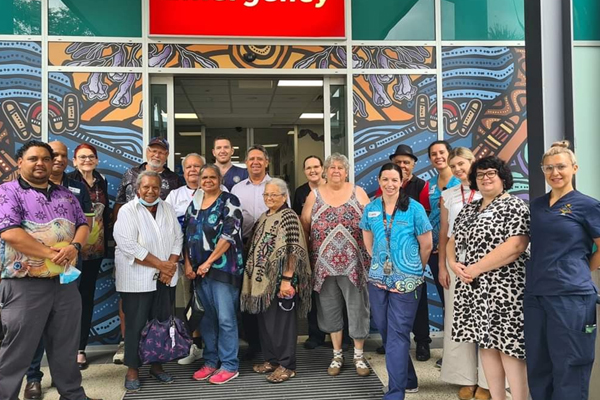RBWH Culturally Welcoming and Responsive Emergency Department

Metro North Health Emergency Department staff, Aboriginal and Torres Strait Islander Elders and community members.
Over the last five years, the RBWH Emergency and Trauma Centre (ETC) has seen a 33% increase in annual presentations by people who identify as Aboriginal and Torres Strait Islander (to almost 4000 per year). Almost 1 in 5 Aboriginal and Torres Strait Islander patients presenting to the RBWH Emergency Department leave the Department before being seen or before their treatment is completed. This suggests that our existing model of care disadvantages Aboriginal and Torres Strait Islander peoples. There were two projects undertaken to address this issue. Firstly, a project to make the ETC more culturally welcoming. Secondly, the CAPABLE project was established to introduce a new full time Aboriginal and Torres Strait Islander Senior Health worker to the Emergency Department for 12 months (2021-2022) who, working within the multidisciplinary team, supports patients and promotes cultural safety. This position also helps improve the capacity and capability of staff to provide culturally appropriate healthcare.
The Emergency Department team started by exploring potential resources and barriers for staff and Aboriginal and Torres Strait Islander peoples in either accessing or working in emergency care. From this, a statement of intent was developed to guide the project. The core element of the project was stakeholder engagement including:
- Aboriginal and Torres Strait Islander Elders, community members and community-controlled health services.
- Aboriginal and Torres Strait Islander staff, including cultural capability officers, Indigenous Mental Health Leads and staff from the “Better Together” Van.
- Emergency Department staff.
Consultation used a strengths-based approach and included semi-structured focus groups with a thematic analysis of these gatherings. Some of the consultation occurred as part of NAIDOC week celebrations. Aboriginal and Torres Strait Islander peoples were invited to engage in the 15 Steps Challenge which focuses on how patients experience care by exploring their first impressions in a hospital environment. The project team recorded patients’ perceptions on how the Emergency Department appeared, looked, sounded and smelt. Once consultation was finalised, a community engagement plan was developed highlighting the need to focus on the physical, cultural, emotional and healing elements of the Emergency Department, resulting in the following outcomes:
- approval of artwork throughout the Emergency Department.
- scrub top designed with artwork for clinical staff (noting they can only be worn if appropriate cultural capability training has been completed, as these scrubs are a signpost for cultural safety).
- hosting events for cultural days of significance with staff and local community members.
- changing the workplace culture by reinforcing that cultural safety is everyone’s business and promoting the psychological safety and wellbeing of staff to engage in delivering culturally safe care.
